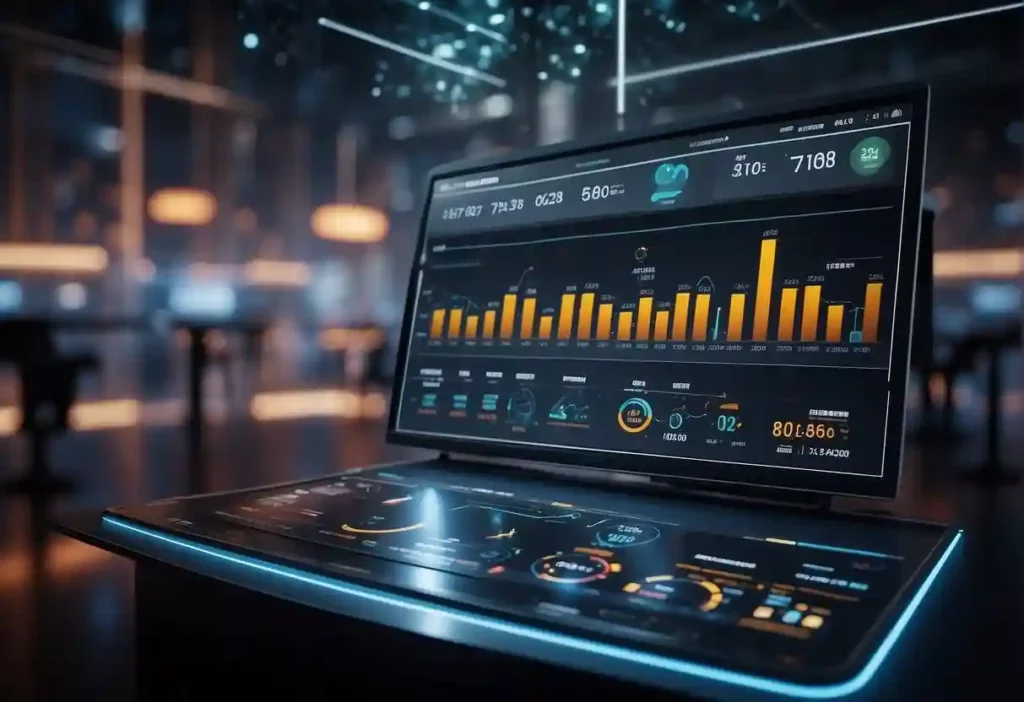24 Game-Changing AI Tools You Absolutely Need in 2024: Enhance Your Productivity and Efficiency

Artificial Intelligence (AI) continues to transform industries, streamline processes, and empower entrepreneurs and professionals with tools that were once considered the stuff of science fiction.
As we stride into 2024, the integration of AI into our daily work has not just become common practice but a competitive necessity. Innovative tools with AI at their core are enhancing decision-making through in-depth analytics and data interpretation, offering insights that are both rich and actionable.

These tools are not confined to data analytics alone. Advances in natural language processing are pushing the boundaries of machine-human interaction, allowing for more refined and conversational experiences.
From automating customer service to generating written content, the technology is becoming more nuanced and context-aware. Moreover, creativity and design fields are seeing a surge in AI-driven software that augments human creativity, enabling the creation of complex designs and visuals with an unprecedented ease.
Key Takeaways
- AI tools significantly enhance analytic capabilities and decision-making.
- Advances in AI promote sophisticated interactions and creative endeavors.
- AI adoption is pivotal in programming, cybersecurity, and healthcare progression.
AI-Powered Analytics and Data Interpretation

Advancements in artificial intelligence have revolutionized the field of analytics and data interpretation. Organizations now leverage AI to gain comprehensive, actionable insights from their data in real-time and predict future trends with higher accuracy.
Real-Time Data Analysis Tools
The latest real-time data analysis tools employ AI to process large streams of information instantaneously, allowing businesses to make data-driven decisions faster than ever. For instance, Impetus StreamAnalytix enables companies to visualize and analyze data on the fly, while DataRobot offers enterprises automated machine learning models that continuously learn and adapt.
Predictive Analytics Software
Predictive analytics software has become essential in forecasting future events and behaviors. Softwares like SAS Advanced Analytics and IBM SPSS Modeler provide robust predictive models using AI, which help industries from healthcare to finance in making more informed decisions. These tools can identify patterns and trends in historical data, enabling users to forecast future outcomes with reliability.
Natural Language Processing for Data Insights
Natural Language Processing (NLP) for Data Insights transforms the way businesses understand unstructured data. Tools such as Tableau’s “Ask Data” feature and ThoughtSpot allow users to query data using natural language and receive insights in plain English. This technology breaks down complex data findings into easily digestible information, making data accessible to a wider range of users irrespective of their technical expertise.
Next-Generation Natural Language Processing

Next-generation natural language processing (NLP) technologies have transformed how humans interact with machines, offering nuanced and complex interaction capabilities and providing concise, relevant text generation and summarization.
Advanced Chatbots and Virtual Assistants
Advanced Chatbots and virtual assistants in 2024 have become indistinguishable from human interaction for many customer service applications.
These systems utilize deep learning algorithms to understand and respond to user inquiries with a high degree of accuracy and personalization. Virtual Assistants have expanded beyond customer service, assisting with a range of tasks from scheduling to data analysis, often via integration with various business software platforms.
- Key features include:
- Natural language understanding
- Emotion recognition
- Contextual awareness
- Multilingual support
Language Generation and Summarization Tools
Language Generation Tools in 2024 efficiently create human-like text for a plethora of applications including content creation, code generation, and automated reporting. These NLP tools are trained on extensive datasets, allowing them to generate coherent and contextually appropriate content.
Summarization Tools have become crucial for managing the information overload, giving users swift and accurate summaries of lengthy documents, emails, and articles.
The most cutting-edge tools now offer customization options, allowing tailoring of summaries to specific user interests or professional needs.
- Capabilities include:
- Customizable length and focus of summaries
- High fidelity to original text’s meaning
- Cross-domain adaptability
- Real-time processing
Revolutionary Design and Creativity Software

In 2024, AI-driven design and creativity software have transformed the landscape of visual and digital content creation. With intelligent algorithms at their core, these tools enhance efficiency and innovation for professionals and enthusiasts alike.
AI-Driven Graphic Design Platforms
AI-Driven Graphic Design Platforms leverage the power of machine learning to simplify complex design tasks.
Adobe Sensei, for example, provides smart features like content-aware fill and auto-masking, which allow designers to perform intricate image manipulations with ease. Canva’s Magic Resize tool automatically adapts graphics to various formats, a time-saver for multi-platform content creators.
| Platform | Notable Feature | Ideal For |
|---|---|---|
| Adobe Sensei | Auto-masking | Professional graphic designers |
| Canva | Magic Resize | Social media marketers |
Automated Content Creation Tools
Automated Content Creation Tools, such as Jasper and Writesonic, specialize in text generation and ideation. They assist in crafting compelling copy across genres, from marketing to storytelling, through advanced language models. These tools are essential for content creators seeking to maintain a consistent and high-quality output with minimal manual effort.
- Jasper: Excellent for long-form content generation.
- Writesonic: Suited for snappy marketing copy.
Intelligent Video Editing Solutions
With Intelligent Video Editing Solutions, editing video content is no longer a daunting task. Software such as Runway and Descript offer features like automated object removal and scene detection, enabling editors to focus on storytelling rather than technical hurdles. They also include AI-powered features like voice synthesis and auto-captioning, making video content more accessible.
- Runway: Streamlines complex visual effects.
- Descript: Offers powerful audio editing and podcasting tools.
AI Tools for Developers and Programmers

Developers and programmers can harness the power of AI to streamline their code creation process, swiftly identify and resolve bugs, and work within advanced environments that augment their productivity and efficiency.
Automated Code Generation
AI tools have revolutionized the way code is generated, offering tailored snippets and boilerplate code that can save developers hours of manual work. GitHub Copilot is a prime example; it uses OpenAI’s codex to suggest whole lines or blocks of code as you type. Another noteworthy tool is DeepCode, which scans repositories for patterns and can automate coding tasks, reducing repetitive strain.
AI-Powered Code Review & Debugging
The introduction of AI into code review and debugging has dramatically increased the accuracy and speed at which developers can deliver pristine code.
Tools like Code Climate leverage AI algorithms to assess quality, maintainability, and test coverage, offering insights through dashboards. For debugging, Kite uses machine learning to provide real-time code completion and error correction, making the debugging process more intuitive.
| Tool | Feature | Use Case |
|---|---|---|
| Code Climate | Quality Metrics | Reviewing code maintainability |
| Kite | Real-Time Assistance | Debugging and Error Correction |
Intelligent Development Environments
Intelligent Development Environments (IDEs) transform how developers interact with their coding workspace by integrating an array of AI tools.
Microsoft Visual Studio IntelliCode is an example that extends the capabilities of Visual Studio with AI-assisted code completions based on patterns found in the codebase.
Meanwhile, JetBrains’ Projector connects to machine learning models to offer smart coding assistance, taking context-aware help to the next level.
- Visual Studio IntelliCode
- AI-Assisted Code Completions
- Learns from the codebase
- JetBrains’ Projector
- Smart Coding Assistance
- Context-Aware Models
AI in Cybersecurity

In 2024, AI technologies have become essential for detecting advanced cyber threats and securing networks. These sophisticated AI tools offer real-time monitoring and rapid response capabilities, significantly strengthening an organization’s cybersecurity posture.
Threat Detection and Response Systems
AI-powered Threat Detection and Response (TDR) systems have revolutionized cybersecurity. They use machine learning algorithms to analyze patterns and behaviors across vast datasets. By doing so, they identify anomalies that could signal a cyberattack. These systems are capable of:
- Automated threat detection: AI algorithms continuously monitor for signs of malicious activity, often catching subtle indicators missed by traditional methods.
- Rapid response: Upon detection, AI TDR systems can automatically take pre-defined actions to contain and mitigate threats, minimizing damage.
AI-Based Network Security
In the realm of AI-Based Network Security, artificial intelligence bolsters defenses by understanding normal network behavior and flagging deviations. Key advantages include:
- Enhanced traffic analysis: AI tools analyze network traffic in real-time, identifying potential security breaches or unauthorized data exfiltration attempts.
- Predictive capabilities: Leveraging predictive analytics, AI can forecast potential security vulnerabilities and suggest proactive measures to prevent breaches.
Impact of AI on Healthcare

Artificial intelligence has significantly advanced the capabilities in healthcare diagnostics and treatment planning. These technologies are now critical in enhancing patient care and treatment outcomes.
Diagnostic and Imaging Tools
AI-driven diagnostic and imaging tools have revolutionized the way clinicians detect diseases. Leading-edge machine learning models can analyze medical images with unprecedented accuracy, often surpassing human experts.
- Improved Detection: AI algorithms excel at detecting subtle patterns in medical images like X-rays, MRI, and CT scans. These patterns might be missed by the human eye.
- Speed: AI can evaluate images much more quickly than medical staff, leading to faster diagnosis for patients.
Personalized Treatment Planning
AI’s role in personalizing treatment plans tailors healthcare to individual patient needs, potentially increasing the effectiveness of treatments.
- Data Synthesis: AI systems integrate vast amounts of patient data — from genetic information to lifestyle factors — to recommend the most effective treatment options.
- Outcome Prediction: By analyzing historical treatment data, AI can predict patient outcomes, thereby aiding doctors in making better-informed treatment decisions.
